LG 29EA93 Monitor Review - Rev. 1.25
by Chris Heinonen on February 12, 2013 8:49 PM ESTOnce again we are copying our charts from our Tablet and Smartphone workflow here for monitors. As I mentioned earlier, you can’t compare these to prior results due to the use of dE2000 for numbers. Another key change here is the ability to use meter profiling for doing measurements, which I’ll elaborate on here a bit to put these numbers into context.
There are two main types of meters: colorimeters and spectrometers. Colorimeters are usually cheaper, and use color filters to read the different colors of light. Spectrometers often cost more but actually “read” the light instead of using filters. This difference is key as color filters were very good when the only light sources were CRTs or CCFL lamps, but now with White and Multi-colors LEDs, and OLED displays, we have light with a different spectral makeup than before, which the filters are often not designed around. This can cause a colorimeter to have incorrect readings but a spectrometer will not.
The reason we don’t always use spectrometers is because they are much slower, and they read at low light much worse that a colorimeter. With meter profiling, you use a spectrometer and colorimeter to read colored patches from a display, and then the software analyzes the results. This creates a 3x3 correction matrix for the colorimeter that then allows it to correctly read the light from the display, even if it is LED or OLED based. The key thing here is this now allows us to read shadows better, and do more readings to produce better results.
The main area of difference here is going to be in blues. Compared to 100% White, 100% Blue has only 7% of the light output, making it very dim. This makes it harder to read for a spectrometer, which makes it more prone to error. Now that we can use a profiled colorimeter to make this reading, and in my case use a C6 meter that can average 10 results at a time to produce a more accurate number, our blue numbers may be different than before, but they will be more accurate.
| Pre-Calibration | 200 cd/m² Target | 80 cd/m² Target | |
| Primary and Secondaries dE2000 | 2.3002 | 1.4839 | 2.0847 |
| Colorchecker dE2000 | 2.1689 | 1.0185 | 0.9915 |
| Saturations dE2000 | 1.7017 | 1.0126 | 1.1254 |
With that out of the way, we can look at the CIE gamut chart and see that the LG 29EA93 has a bit more than the sRGB gamut available, with reds and greens that extend beyond the CIE triangle. Pre-calibration our numbers look very good, but with a bit of over-saturation in the reds and greens. The 200 cd/m² calibration numbers look better than the 80 cd/m² when it comes to the CIExy chart, but frankly I’m more concerned with the color checker and saturation charts. Most people only focus on the CIE chart, but it really just shows the performance of 6 colors and the size of the gamut, but tells you nothing about the performance of the other 16.7 million colors you might use.
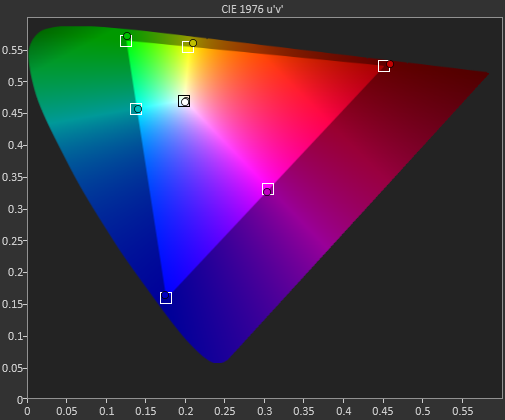
Pre-calibration, the dE2000 number for the Color Checker chart is quite good on the LG 29EA93. Until we have more monitors done with the new workflow we can’t be certain of how good this is, but overall it does look very nice. The main issues are in pure white, and those Yellow-Red-Green tones that fall at the edge of the gamut. The bit of over-saturation that we saw earlier causes these to be a bit too-rich and leads to some visible errors there.
After calibration, only those over-saturated colors provide anything to care about at all. Beyond those four points, the other 20 samples are nearly perfect, with no visible error at all even in blues. If those final four points were perfect there would be nothing to complain about at all with the LG 29EA93, but even with them it produces overall dE2000 numbers that are fantastic.
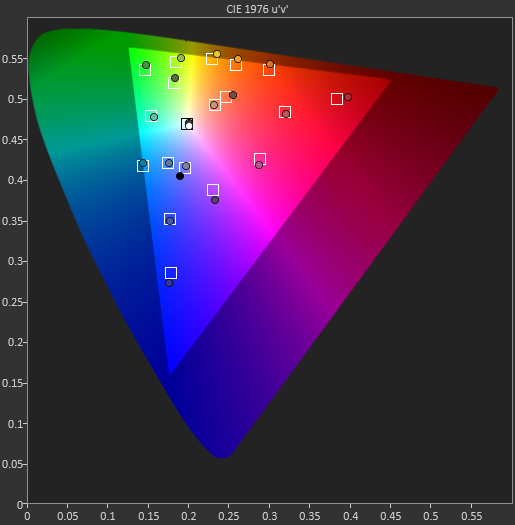
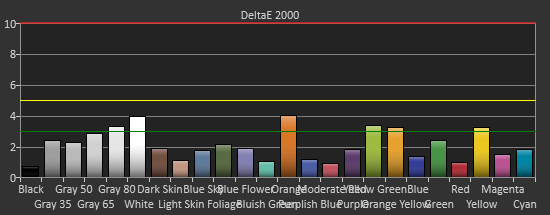
Pre-calibration, the saturation numbers for the LG are good, but you can see quite a few of the measurements are at or close to the dE2000 3.0 mark. Post-calibration this improves, especially the 20% data, with only the 100% green and yellow color swatches measuring over 3.0, and only four measurements total over a dE2000 of 2.0. The calibrations push the saturation measurements from good to excellent.
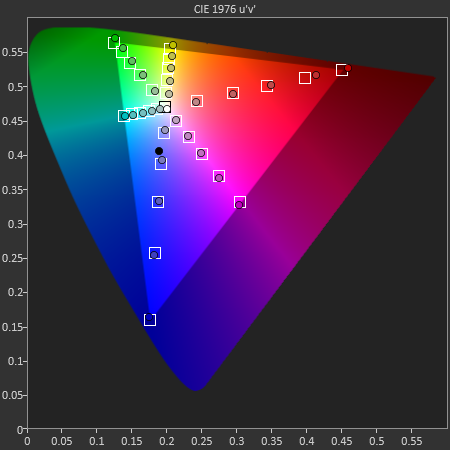
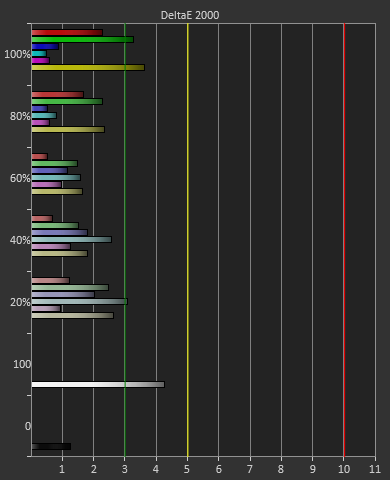
Taking these measurements in full, it seems that after calibration, the only place you will see any color errors on the LG 29EA93 is in a fully saturated red, green, or possibly yellow. As soon as the saturation drops below 100% the error level drops drastically, and you won’t be able to see an error at all. Unless you start at a pure-red screen all day long, the color of the LG 29EA93 is going to be very impressive.











108 Comments
View All Comments
cheinonen - Wednesday, February 13, 2013 - link
On every recent LED in house I've tried to test for PWM, but all photographs wind up with a solid line which indicates one of two things:- No PWM
- I'm doing it wrong
Believe me, I'm testing it, but unless I can get a positive result to ensure that the testing method is correct, I am not confident to state for a fact that a display does or does not feature it.
paradeigmas - Wednesday, February 13, 2013 - link
Thank you for the most useful and insightful review. Do you think you would be able to review the new ASUS MX299Q which is sold at a significantly lower price point ($599) than the LG29EA93? That would be tremendously helpful in determining which one to buy.99sport - Wednesday, February 13, 2013 - link
It makes absolutely no sense to me that LG would sell a home calibration kit (that only works with one particular model of monitor) for $100-$150. For that money, why wouldn't LG calibrate the display at the factory? That would save me the hassle of doing the calibration myself and LG wouldn't have to stock, ship and support the calibration kit, which I would only need once or twice in my lifetime.I have some experience doing display calibration, and my next monitor purchase will be a factory calibrated Dell (if I had a Mac it would be a factory calibrated Apple display). For those interested, the process of calibrating my Samsung TV consisted of buying the colorimiter for $150, finding and burning a BluRay of the test patterns (need a BlyRay burner for this), downloading the calibration software, and then figuring out what all the terms mean and how to do the calibration. Unfortunately, display calibration is highly iterative as changing one setting often upsets others. Plus the calibration is never perfect, so you are constantly trading one parameter for another - hoping to maximize as many parameters as possible. In the end, I was able to achieve a very good result, and this saved me from returning the TV (I was very disappointed in the color accuracy before calibration), but I spent three days figuring out what I was doing and then iterating a number of times - Like I said earlier, I would gladly pay $100 to be able to take the display out of the box and use it knowing the factory achieved an acceptable baseline. I assume LG's product is much more of a point and click affair then what I used, but that would mean it would be that much easier for them to do in house. They could even have a separate SKU for those willing to pay more for factory calibration.
Spoelie - Wednesday, February 13, 2013 - link
Calibration is dependent on the device outputting the video signal. You could calibrate your TV perfectly for your bluray player, but have it completely miss the spot when connecting your xbox (or whatever). That's why each input will have its own settings on a "sane" TV.Some calibration can already be done in the factory though, that's true, it just won't be perfect. Panasonic does this with their G-range (and up) televisions, called THX-Cinema mode. See http://www.hdtvtest.co.uk/news/panasonic-tx-p50gt5...
cheinonen - Thursday, February 14, 2013 - link
You can go back and read some of my comments about the meter and how they likely build in profiles to account for the spectral signature of the LED backlighting.With a $100 colorimeter, like the i1Display2 or a Spyder, the simple fact is they are decent at what they do, but they drift relatively fast, and they work best on CCFL or CRT based displays. LED based LCDs and other lighting systems typically don't work well on them. The issue is that when using software to do the calibration, neither one of those items knows if the meter is reading correctly or incorrectly. Without verification by a spectrometer, you'd have no idea.
The human eye is also very adaptable to what we see in front of us, and we adjust very fast. Whatever the brightest white is, we take that to be pure white and adjust from that. If a display is 9300K or 4500K instead of 6500K, I can typically spot that. If it's 6200K or 6800K and there is no 6500K reference in the room, your eye is going to adapt to that being correct.
If they can program their meter to work better with their displays than the XRite or Datacolor solutions, and sell it for less, then for many people it's going to work fine. Calibrating at the factory adds time and money that many people don't care about unfortunately. For people like myself, we might pay the extra $100 for it, but for many people that $100 would mean they buy a different display. Multiple SKUs also make vendors and dealers unhappy, as it's more inventory to track and they'd rather just carry a calibration device.
99sport - Wednesday, February 13, 2013 - link
I want to thank AnandTech for being one of a few websites that check greyscale and color performance of displays - this site does an outstanding and thorough job. However, I agree with many other posters who believe this follow up test should be of a retail unit.As I understand it, some manager at LG read your previous review and then ordered his engineers to improve the display and have it retested. As an engineer who worked in a large corporation for many years, it is unthinkable to me that LG would pull a display off the assembly line and send it to you without first verifying it's performance. It would be a great way for the person given the task of improving the display to get fired if the second review does not live up to whatever goals LG management had. My hunch is that they either pulled a number of samples off the line, checked their performance and sent the best one, or took a random unit and then tweaked it to achieve the performance goals they were after.
While it may be cost prohibitive to purchase every device tested on this site, this is clearly a case where the lack of a store bought sample casts doubt on the validity of the results.
flamefox777 - Wednesday, February 13, 2013 - link
No Gold award?Is this "the" gaming and movie-watching monitor out right now?
Am I 100% absolutely certain to get this new revision if I order from Amazon or Newegg?
xaueious - Wednesday, February 13, 2013 - link
Can you provide information on where you can tell the difference between the two?Also, there's a typo on the first page '28EA93'?
DelphiOracle - Thursday, February 14, 2013 - link
I would be very suspicious of any piece of hardware delivered for review with an company engineer. I suggest re-evaluating the monitor using a retail version. It is all too easy (and tempting) for the company to deliver a piece of hardware that has been screened and tweeked by the gift bearer!Wolfpup - Thursday, February 14, 2013 - link
And surprising! I'm more used to companies just ignoring things, never responding, or worse. Really cool to see they were so awesomely responsive and fixed it!Will make me less nervous about buying an LG monitor or display...